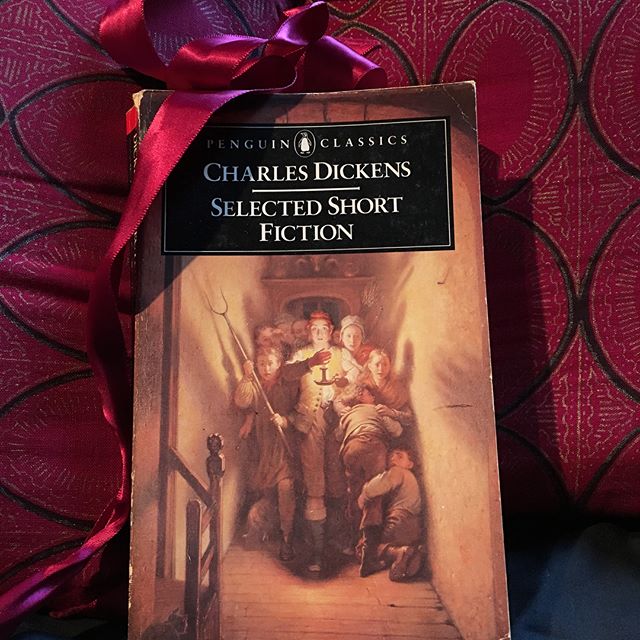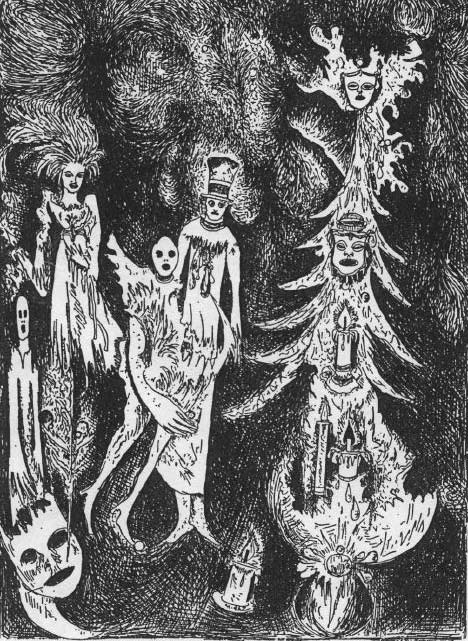Charles Dickens is so well known for “A Christmas Carol,” that some of his other Christmas Tales are too sadly overlooked. In my favorite, the unassumingly-titled “A Christmas Tree,” the narrator muses over a tabletop Christmas Tree toy, and descends into haunted recollections about his own childhood toys and seasonal experiences in a manner that first celebrates their wonder and joy but which grows progressively darkened by the specter of death. He describes the tree itself as a kind of descent: “I observe in this tree the singular property that it appears to grow downward towards the earth — I look into my youngest Christmas recollections!” These recollections are attached to objects — toys, puppets, tree ornaments, etc. — that are framed as if they contain repressed memories, and return as puzzling artefacts of doom. As he reflects, e inevitably begins to think of ghosts — a classic embodiment of the “return of the repressed” — but as I re-read Dickens’ piece recently I became enamored with his discussion of an old paper mask, which he describes in ways that reveal the phenomenology of the uncanny in a way that echoes the work of Freud and Rank.
When did that dreadful Mask first look at me? Who put it on, and why was I so frightened that the sight of it is an era in my life? It is not a hideous visage in itself; it is even meant to be droll, why then were its stolid features so intolerable? Surely not because it hid the wearer’s face. An apron would have done as much; and though I should have preferred even the apron away, it would not have been absolutely insupportable, like the mask. Was it the immovability of the mask? The doll’s face was immovable, but I was not afraid of her. Perhaps that fixed and set change coming over a real face, infused into my quickened heart some remote suggestion and dread of the universal change that is to come on every face, and make it still? Nothing reconciled me to it. No drummers, from whom proceeded a melancholy chirping on the turning of a handle; no regiment of soldiers, with a mute band, taken out of a box, and fitted, one by one, upon a stiff and lazy little set of lazy-tongs; no old woman, made of wires and a brown-paper composition, cutting up a pie for two small children; could give me a permanent comfort, for a long time. Nor was it any satisfaction to be shown the Mask, and see that it was made of paper, or to have it locked up and be assured that no one wore it. The mere recollection of that fixed face, the mere knowledge of its existence anywhere, was sufficient to awake me in the night all perspiration and horror, with, “O I know it’s coming! O the mask!” — Dickens, “A Christmas Tree”
The uncanny paper mask cannot be “locked up” and is “coming” after the narrator, because it exists with a kind of autonomous and inexplicable power as a childhood memory, and neither logic nor cultural traditions (like Christmas ritual) can explain it; the mask can only raise questions that reason cannot answer. The surface of the mask directly reflects the dreadful permanence and inevitability of death, that “universal change that is to come on every face, and make it still.”
In “The Gothic Side of Familiar Things,” Clotilda de Stasio inquires into “A Christmas Tree” and analyzes not only how the story vacillates between reality and unreality, comfort and disturbance, but also features an examination of artwork by Mirando Haz, who made etchings based on the story to capture “all the paraphernalia of the unconscious,” including masks:
Stasio comes to the conclusion that “a visual shock is fundamental to the reader’s reception as it helps the narrator to achieve an effect of truth that would otherwise be unattainable.” This is the gateway that the uncanny signals — a reaction to change, founded in the longing and unreality of wishes and their ability to shatter the very foundation of culturally-constructed realities that undergird most adult, civilized beliefs.
Happy Holidays.


Happy festive season to you too 🙂 Thank you for sharing this. Ghostly stories, particularly the ones where you’re not really sure how far the story is taking you from reality to otherness, are the reason why I became interested in the area of the uncanny in the first place so this was a deliciously evocative read.
The section you quoted, where the poor narrator worries at the reason for their fears, put me in mind of the uncanny on another level, as it reflected what I’ve encountered in trying to make sense of how we research this area. I’ve long been vexed by the circular nature of asking questions about this liminal experience, where as soon as you identify something that seems to trigger the effect, you start to question if it’s uncanny because of its near-humanlike traits, or do those flaws in human-likeness cause us to label it as uncanny and respond accordingly. I’ve proposed a solution to that quandary through empirical measurement of variables that can be visualised so the researcher can see the relationship between them and cut through the circularity. Handy for psychological research, not so much for literature!
Wishing you well,
Steph.